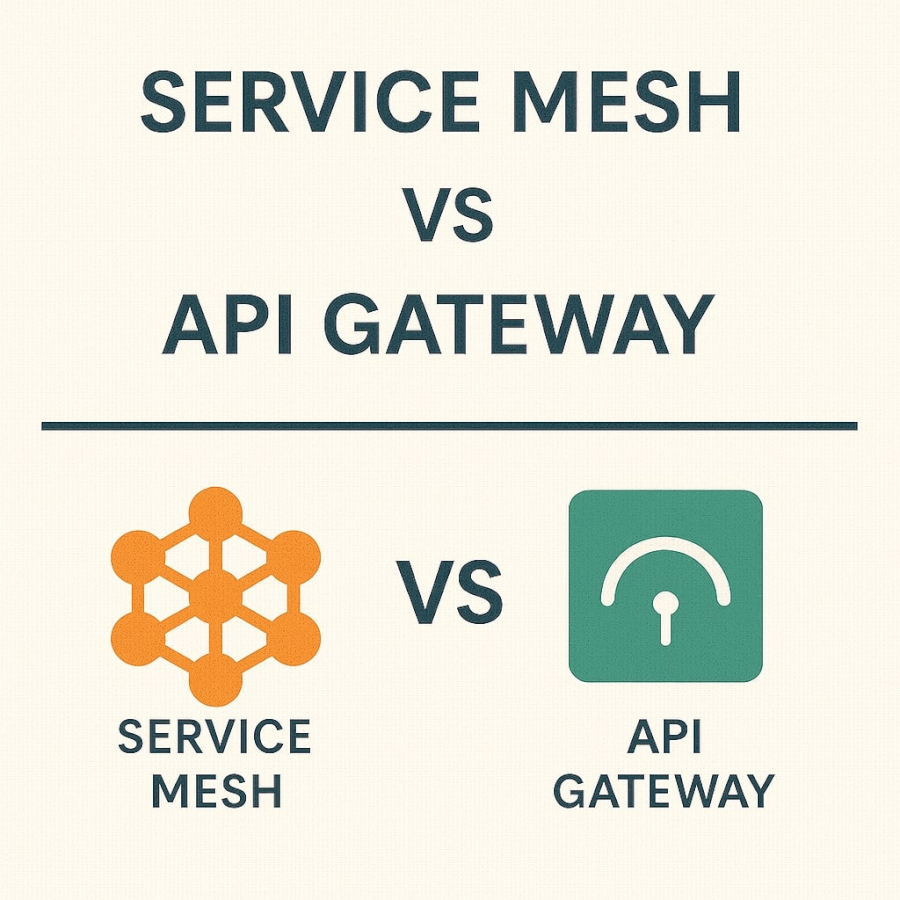Service Mesh vs API Gateway: When and Why You Need Them
26 May 2025
Modern distributed systems present complex challenges in managing communication, security, and observability across multiple services. Two architectural patterns have emerged as essential solutions: Service Mesh and API Gateways. While both address service-to-service communication, they serve different purposes and solve distinct problems in cloud-native architectures.
This comprehensive guide explores the differences between Service Mesh and API Gateway patterns, their respective strengths and limitations, and provides clear guidance on when and why you should implement each solution in your architecture.
Understanding Service Mesh Architecture
Service Mesh is an infrastructure layer that handles service-to-service communication within a distributed application architecture. It provides a transparent way to add capabilities like load balancing, service discovery, failure recovery, metrics collection, and security policies without requiring changes to application code.
The service mesh operates through a network of lightweight proxies deployed alongside each service instance, typically as sidecar containers in Kubernetes environments. These proxies intercept all network communication between services, applying policies and collecting telemetry data while remaining invisible to the application layer.
Popular service mesh solutions include Istio, Linkerd, Consul Connect, and AWS App Mesh. Each implementation provides similar core functionality while differing in complexity, performance characteristics, and ecosystem integration approaches.
The key value proposition of service mesh lies in its ability to extract cross-cutting concerns from application code, enabling consistent implementation of communication policies across all services regardless of the programming language or framework used.
API Gateway Fundamentals
An API Gateway serves as a single entry point for client requests to backend services, acting as a reverse proxy that routes requests to appropriate services while providing cross-cutting functionality like authentication, rate limiting, request transformation, and response aggregation.
API Gateways primarily focus on north-south traffic (client-to-service communication) rather than east-west traffic (service-to-service communication). They provide a unified interface for external clients while abstracting the complexity of underlying microservices architectures.
Leading API Gateway solutions include Kong, Ambassador, AWS API Gateway, Azure API Management, and cloud-native options like Istio Gateway and Envoy Gateway. These platforms offer varying levels of functionality, from simple reverse proxying to comprehensive API management capabilities.
The core purpose of API Gateways is to simplify client integration while providing centralized control over API access, security policies, and traffic management for external-facing services.
Key Differences Between Service Mesh and API Gateway
Traffic Direction and Scope
The fundamental difference lies in traffic direction and architectural scope. API Gateways manage north-south traffic between external clients and internal services, providing a single entry point and unified interface for API consumers.
Service Mesh focuses on east-west traffic between services within the application boundary, ensuring secure, reliable, and observable communication between microservices without exposing internal service details to external clients.
This distinction means API Gateways are client-facing while Service Mesh operates entirely within the internal service network, making them complementary rather than competing solutions.
Functionality and Capabilities
API Gateways provide client-facing functionality including request routing, authentication, authorization, rate limiting, request/response transformation, API versioning, and developer portal capabilities. These features support external API consumption and management.
Service Mesh offers service-to-service communication features including mutual TLS encryption, circuit breaking, retry policies, load balancing, service discovery, distributed tracing, and traffic splitting for canary deployments. These capabilities enhance internal service reliability and observability.
While some functionality overlaps, each solution optimizes for different use cases and traffic patterns, making their feature sets complementary in comprehensive distributed architectures.
Implementation and Deployment Models
API Gateways typically deploy as centralized components at the network edge, either as dedicated instances or as part of ingress controllers in Kubernetes environments. This centralized model enables consistent policy enforcement for all incoming traffic.
Service Mesh deploys in a distributed manner with proxy sidecars running alongside each service instance. This distributed model ensures communication policies apply consistently across all service interactions without creating central bottlenecks.
The deployment model difference reflects their distinct architectural purposes and the types of traffic they're designed to handle.
When You Need an API Gateway
External API Management
API Gateways are essential when exposing internal services to external clients, partners, or public API consumers. They provide the necessary abstraction layer to hide internal service complexity while presenting a clean, versioned API interface.
The gateway enables API lifecycle management including versioning, deprecation, and backward compatibility without requiring changes to underlying services. This capability is crucial for maintaining stable external interfaces while allowing internal service evolution.
API documentation, developer portals, and SDK generation features make API Gateways valuable for organizations building API-first products or platform services consumed by external developers.
Security and Access Control
When external clients need access to internal services, API Gateways provide essential security capabilities including authentication, authorization, and threat protection. They can integrate with identity providers, implement OAuth flows, and enforce fine-grained access policies.
Rate limiting and DDoS protection features help protect backend services from abuse and ensure fair resource allocation among API consumers. These capabilities are particularly important for public APIs or partner integrations.
API Gateways also provide audit logging and monitoring for external API usage, enabling compliance and business intelligence capabilities that are difficult to implement at the individual service level.
Protocol Translation and Aggregation
API Gateways excel at protocol translation, enabling REST clients to interact with GraphQL services, or modern web applications to access legacy SOAP services. This capability is valuable during modernization efforts or when supporting diverse client requirements.
Response aggregation allows API Gateways to combine data from multiple backend services into unified responses, reducing client complexity and network overhead. This pattern is particularly useful for mobile applications with limited bandwidth or processing capabilities.
Request and response transformation features enable API evolution without breaking existing clients, supporting gradual migration strategies and backward compatibility requirements.
When You Need a Service Mesh
Microservices at Scale
Service Mesh becomes valuable when managing communication between numerous microservices where manual configuration of service-to-service policies becomes impractical. The infrastructure provides consistent policy enforcement across all services regardless of implementation technology.
In environments with dozens or hundreds of services, Service Mesh eliminates the need to implement communication logic in each service, reducing development overhead and ensuring consistent behavior across the entire service landscape.
The automatic service discovery and load balancing capabilities become essential as the number of service instances scales dynamically based on load and deployment patterns.
Security and Compliance Requirements
When organizations require mutual TLS encryption for all service-to-service communication, Service Mesh provides automatic certificate management and encryption without requiring application code changes. This capability is crucial for compliance with security standards and regulatory requirements.
Service Mesh enables zero-trust networking principles by default, ensuring all communication is authenticated and encrypted while providing fine-grained access control policies between services.
The infrastructure also supports security policy automation, enabling consistent application of security controls across all services without relying on individual development teams to implement security correctly.
Observability and Debugging
Service Mesh provides comprehensive observability for service-to-service communication including distributed tracing, metrics collection, and access logging. This visibility is essential for debugging complex distributed systems and understanding performance characteristics.
The automatic metric collection enables monitoring of service health, performance, and communication patterns without requiring instrumentation changes in application code. This capability becomes critical as system complexity increases.
Distributed tracing capabilities help identify performance bottlenecks and debug issues that span multiple services, which is often challenging in traditional monitoring approaches.
Popular Service Mesh Solutions
Istio: Comprehensive but Complex
Istio provides the most comprehensive service mesh capabilities including advanced traffic management, security policies, and observability features. The platform integrates well with Kubernetes and offers extensive customization options for complex requirements.
Istio's strength lies in its feature completeness and flexibility, supporting advanced use cases like multi-cluster deployments, complex traffic routing scenarios, and sophisticated security policies. The platform's extensive ecosystem and community support make it suitable for enterprise environments.
However, Istio's complexity can be overwhelming for smaller deployments or teams lacking extensive Kubernetes expertise. The learning curve is steep, and operational overhead can be significant without proper expertise and tooling.
Linkerd: Simplicity and Performance
Linkerd focuses on simplicity and performance, providing essential service mesh capabilities with minimal configuration overhead. The platform emphasizes ease of deployment and operation while maintaining strong security and observability features.
Linkerd's ultra-light proxy architecture provides excellent performance characteristics with minimal resource overhead. The platform's opinionated approach reduces configuration complexity while still providing essential service mesh benefits.
The trade-off for simplicity is reduced flexibility compared to more comprehensive solutions. Organizations with complex routing requirements or advanced policy needs may find Linkerd's capabilities insufficient.
AWS App Mesh: Cloud-Native Integration
AWS App Mesh provides service mesh capabilities with deep integration into AWS services and infrastructure. The managed service approach reduces operational overhead while providing enterprise-grade reliability and support.
App Mesh integrates seamlessly with AWS container services, load balancers, and observability tools, making it an attractive option for organizations heavily invested in the AWS ecosystem. The managed nature eliminates much of the operational complexity associated with self-managed service mesh deployments.
However, the AWS-specific nature limits portability and may create vendor lock-in concerns for organizations with multi-cloud strategies or plans to migrate between cloud providers.
Leading API Gateway Solutions
Kong: Enterprise-Grade Open Source
Kong provides a comprehensive API Gateway platform with both open-source and enterprise editions. The platform offers extensive plugin ecosystem, high performance, and flexibility for complex API management requirements.
Kong's strength lies in its plugin architecture that enables extensive customization and integration with various systems. The platform supports both traditional deployment models and cloud-native Kubernetes deployments through Kong Ingress Controller.
The enterprise edition adds advanced features like multi-datacenter deployments, advanced analytics, and enterprise support, making it suitable for large-scale production environments.
Ambassador: Kubernetes-Native
Ambassador (now Emissary-Ingress) provides a Kubernetes-native API Gateway built on Envoy Proxy. The platform integrates seamlessly with Kubernetes workflows and provides GitOps-friendly configuration management.
Ambassador's Kubernetes-native approach makes it particularly suitable for cloud-native environments where traditional API Gateway deployment models may not align well with container orchestration patterns.
The platform's focus on developer experience and GitOps integration appeals to organizations adopting modern development practices and seeking to integrate API management into existing CI/CD workflows.
AWS API Gateway: Serverless Management
AWS API Gateway provides a fully managed service for creating, deploying, and managing APIs at scale. The serverless approach eliminates infrastructure management while providing enterprise-grade capabilities and AWS service integration.
The managed service model provides automatic scaling, built-in monitoring, and integration with AWS security and compliance services. This approach is particularly attractive for organizations seeking to minimize operational overhead.
However, the AWS-specific nature and potential vendor lock-in concerns may limit adoption for organizations with multi-cloud strategies or specific portability requirements.
Combining Service Mesh and API Gateway
Complementary Architecture Patterns
Service Mesh and API Gateway serve complementary roles in comprehensive distributed architectures. API Gateways handle external client communication while Service Mesh manages internal service-to-service communication, creating a complete communication infrastructure.
This combination enables organizations to benefit from both external API management capabilities and internal service communication enhancements without architectural conflicts or redundancy.
The complementary nature means organizations can adopt these solutions independently based on specific requirements and gradually build comprehensive communication infrastructure.
Integration Considerations
When implementing both solutions, consider integration points and potential overlap in functionality. Some service mesh solutions include ingress gateway capabilities that may overlap with standalone API Gateway features.
Ensure consistent security policies and observability data collection across both API Gateway and Service Mesh components. This consistency is important for comprehensive security monitoring and debugging capabilities.
Plan for unified observability and monitoring that correlates data from both API Gateway and Service Mesh components to provide complete visibility into application communication patterns.
Implementation Best Practices
Gradual Adoption Strategy
Implement Service Mesh and API Gateway solutions gradually, starting with non-critical services or specific use cases to gain experience and validate benefits before full-scale deployment.
Begin with basic functionality and gradually add advanced features as team expertise develops. This approach reduces risk and enables learning from early implementations to inform broader deployment strategies.
Consider pilot projects that demonstrate value and build organizational confidence in the technology before committing to enterprise-wide deployment.
Team Training and Expertise
Invest in team training and expertise development for both Service Mesh and API Gateway technologies. These solutions require new operational skills and architectural understanding that may not exist in traditional development teams.
Establish centers of excellence or platform teams responsible for managing and supporting these infrastructure components. This approach ensures consistent implementation and reduces the learning burden on individual application teams.
Consider engaging with vendors, consultants, or community resources to accelerate expertise development and avoid common implementation pitfalls.
Monitoring and Observability
Implement comprehensive monitoring and observability for both Service Mesh and API Gateway components. These infrastructure elements become critical to application functionality and require appropriate monitoring to ensure reliability.
Establish alerting and incident response procedures for infrastructure component failures. Service Mesh and API Gateway outages can impact multiple applications simultaneously, requiring coordinated response procedures.
Use observability data to continuously optimize performance and identify opportunities for improvement in communication patterns and policy configurations.
Performance and Scalability Considerations
Latency and Throughput Impact
Both Service Mesh and API Gateway introduce additional network hops that can impact application latency and throughput. Evaluate performance implications during planning and testing phases to ensure acceptable performance characteristics.
Service Mesh proxy overhead is typically minimal but can become significant in high-throughput scenarios or latency-sensitive applications. Load testing should include Service Mesh components to validate performance under expected load conditions.
API Gateway performance varies significantly between solutions and deployment configurations. Consider performance requirements when selecting platforms and plan for appropriate scaling strategies.
Resource Utilization
Service Mesh sidecar proxies consume additional CPU and memory resources on each service instance. Factor these resource requirements into capacity planning and cost calculations, especially in resource-constrained environments.
API Gateway resource requirements depend on deployment model and feature usage. Managed services eliminate infrastructure concerns while self-managed solutions require appropriate sizing and scaling strategies.
Monitor resource utilization continuously and optimize configurations based on actual usage patterns rather than theoretical requirements.
Making the Right Choice for Your Architecture
Decision Framework
Evaluate your specific requirements for external API management versus internal service communication to determine which solution provides the most value for your current needs.
Consider organizational readiness including team expertise, operational capabilities, and tolerance for complexity when evaluating different solutions and implementation approaches.
Assess integration requirements with existing infrastructure, security systems, and development workflows to ensure chosen solutions align with current technology strategies.
Starting Points and Evolution
For organizations new to these technologies, consider starting with API Gateway if external API management is a priority, or Service Mesh if internal service communication challenges are more pressing.
Plan for evolution and growth of your communication infrastructure over time. Solutions that work for current requirements should also support future needs as your architecture and organization mature.
Consider cloud-native managed services if operational overhead is a concern, or open-source solutions if flexibility and customization are higher priorities.
Future Trends and Evolution
Convergence and Integration
The boundaries between Service Mesh and API Gateway are becoming less distinct as platforms add overlapping capabilities. Some service mesh solutions now include ingress gateway features, while API Gateways are adding service-to-service communication capabilities.
This convergence may lead to unified platforms that provide both external API management and internal service communication features, simplifying architecture decisions and reducing operational complexity.
Cloud-Native Evolution
Both Service Mesh and API Gateway solutions are evolving to better support cloud-native patterns including serverless computing, edge computing, and multi-cloud deployments.
The integration with Kubernetes and other container orchestration platforms continues to improve, making these solutions more accessible to organizations adopting cloud-native architectures.
Observability and AI Integration
Advanced observability features including AI-powered anomaly detection, predictive scaling, and automated policy optimization are becoming standard features in both Service Mesh and API Gateway platforms.
These capabilities will make the solutions more autonomous and reduce operational overhead while providing better insights into application behavior and performance characteristics.
Conclusion
Service Mesh and API Gateway serve distinct but complementary roles in modern distributed architectures. API Gateways excel at managing external client communication, providing security, and offering API lifecycle management capabilities. Service Mesh focuses on internal service-to-service communication, providing security, reliability, and observability for microservices architectures.
The choice between these solutions depends on your specific requirements, with many organizations ultimately adopting both to create comprehensive communication infrastructure. API Gateways are essential for external API management, while Service Mesh becomes valuable as microservices architectures grow in complexity and scale.
Success with either solution requires careful planning, gradual implementation, and investment in team expertise. The operational complexity and learning curve are significant, but the benefits in terms of security, reliability, and observability make these solutions essential components of modern cloud-native architectures.
As these technologies continue to evolve and converge, organizations should focus on solving their immediate communication challenges while planning for future architectural evolution. The investment in understanding and implementing these patterns will pay dividends as distributed systems become increasingly central to business operations and competitive advantage.

